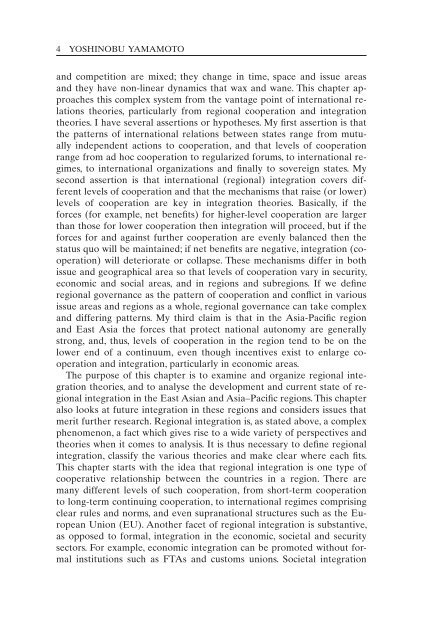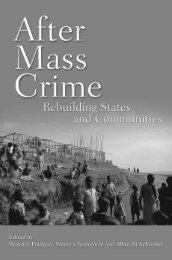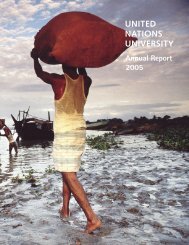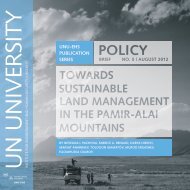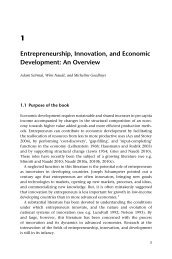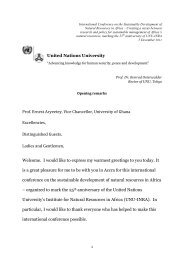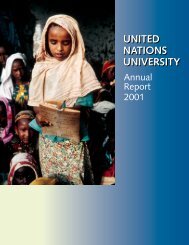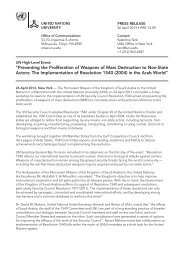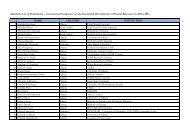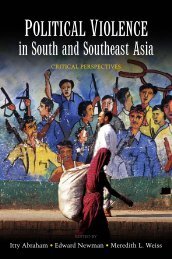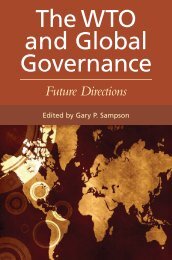Sample Chapter - United Nations University
Sample Chapter - United Nations University
Sample Chapter - United Nations University
You also want an ePaper? Increase the reach of your titles
YUMPU automatically turns print PDFs into web optimized ePapers that Google loves.
4 Yoshinobu Yamamoto<br />
and competition are mixed; they change in time, space and issue areas<br />
and they have non-linear dynamics that wax and wane. This chapter approaches<br />
this complex system from the vantage point of international relations<br />
theories, particularly from regional cooperation and integration<br />
theories. I have several assertions or hypotheses. My first assertion is that<br />
the patterns of international relations between states range from mutually<br />
independent actions to cooperation, and that levels of cooperation<br />
range from ad hoc cooperation to regularized forums, to international regimes,<br />
to international organizations and finally to sovereign states. My<br />
second assertion is that international (regional) integration covers different<br />
levels of cooperation and that the mechanisms that raise (or lower)<br />
levels of cooperation are key in integration theories. Basically, if the<br />
forces (for example, net benefits) for higher-level cooperation are larger<br />
than those for lower cooperation then integration will proceed, but if the<br />
forces for and against further cooperation are evenly balanced then the<br />
status quo will be maintained; if net benefits are negative, integration (cooperation)<br />
will deteriorate or collapse. These mechanisms differ in both<br />
issue and geographical area so that levels of cooperation vary in security,<br />
economic and social areas, and in regions and subregions. If we define<br />
regional governance as the pattern of cooperation and conflict in various<br />
issue areas and regions as a whole, regional governance can take complex<br />
and differing patterns. My third claim is that in the Asia-Pacific region<br />
and East Asia the forces that protect national autonomy are generally<br />
strong, and, thus, levels of cooperation in the region tend to be on the<br />
lower end of a continuum, even though incentives exist to enlarge cooperation<br />
and integration, particularly in economic areas.<br />
The purpose of this chapter is to examine and organize regional integration<br />
theories, and to analyse the development and current state of regional<br />
integration in the East Asian and Asia–Pacific regions. This chapter<br />
also looks at future integration in these regions and considers issues that<br />
merit further research. Regional integration is, as stated above, a complex<br />
phenomenon, a fact which gives rise to a wide variety of perspectives and<br />
theories when it comes to analysis. It is thus necessary to define regional<br />
integration, classify the various theories and make clear where each fits.<br />
This chapter starts with the idea that regional integration is one type of<br />
cooperative relationship between the countries in a region. There are<br />
many different levels of such cooperation, from short-term cooperation<br />
to long-term continuing cooperation, to international regimes comprising<br />
clear rules and norms, and even supranational structures such as the European<br />
Union (EU). Another facet of regional integration is substantive,<br />
as opposed to formal, integration in the economic, societal and security<br />
sectors. For example, economic integration can be promoted without formal<br />
institutions such as FTAs and customs unions. Societal integration


